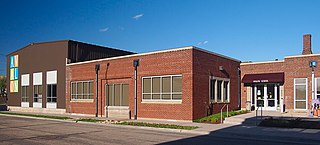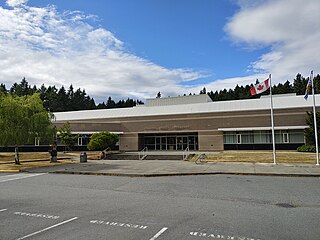A cram school is a specialized school that trains its students to achieve particular goals, most commonly to pass the entrance examinations of high schools or universities. The English name is derived from the slang term cramming, meaning to study a large amount of material in a short period of time. The word "crammer" may be used to refer to the school or to an individual teacher who assists a student in cramming.

A teaching assistant or teacher's aide (TA) or education assistant (EA) or team teacher (TT) is an individual who assists a teacher or professor with instructional responsibilities. TAs include graduate teaching assistants (GTAs), who are graduate students; undergraduate teaching assistants (UTAs), who are undergraduate students; secondary school TAs, who are either high school students or adults; and elementary school TAs, who are adults.

Avalon School is a project-based charter middle school and high school in Saint Paul, Minnesota, United States, located at 700 Glendale Street. As a project-based school, students meet their academic graduation requirements through a combination of independent projects, group projects, and seminars. Individual students' schedules vary depending on the seminars they are enrolled in and the activities they are involved with. Students spend a significant part each day working independently on projects. The school has a flat organizational structure with no principal or director in a position of power. The staff members work collaboratively to manage the school.
In New York State, Regents Examinations are statewide standardized examinations in core high school subjects. Students are required to pass these exams to earn a Regents Diploma. To graduate, students are required to have earned appropriate credits in a number of specific subjects by passing year-long or half-year courses, after which they must pass at least five Regents examinations in some of the subject areas. For higher-achieving students, a Regents with Advanced designation and an Honors designation are also offered. Students with disabilities or enrolled in an English as a Second Language program are able to earn a local diploma.
A homeroom, tutor group, form class, or form is a brief administrative period that occurs in a classroom assigned to a student in primary school and in secondary school. Within a homeroom period or classroom, administrative documents are distributed, attendance is marked, announcements are made, and students are given the opportunity to plan for the day. Such periods also act as a form of pastoral care, where teachers and administrators provide personal, social or health advice. Homerooms differ in their nature, depending on the country and the specific school.

Primary education in the United States refers to the first seven to nine years of formal education in most jurisdictions, often in elementary schools, including middle schools. Preschool programs, which are less formal and usually not mandated by law, are generally not considered part of primary education. The first year of primary education is commonly referred to as kindergarten and begins at or around age 5 or 6. Subsequent years are usually numbered being referred to as first grade, second grade, and so forth. Elementary schools normally continue through sixth grade, which the students normally complete when they are age 11 or 12. Some elementary schools graduate after the 4th or 5th grade and transition students into a middle school.
Education in Romania is based on a free-tuition, egalitarian system. Access to free education is guaranteed by Article 32 in the Constitution of Romania. Education is regulated and enforced by the Ministry of National Education. Each step has its own form of organization and is subject to different laws and directives. Since the downfall of the communist regime, the Romanian educational system has gone through several reforms.
St Joseph's College is a Salesian Roman Catholic boys' secondary school in the outer-eastern suburb of Ferntree Gully, Melbourne, Victoria, Australia.

Brebeuf College School is a publicly funded Roman Catholic all-boys high school in Toronto, Ontario, Canada endorsed by the Jesuits of Canada. Founded by the Jesuits in 1963, it is part of the Toronto Catholic District School Board and associated with the Presentation Brothers since 1984. Brebeuf is the brother school of nearby St. Joseph's Morrow Park Catholic Secondary School.

Our Lady of Mercy School for Young Women is a private all-girls Catholic school teaching grades 6–12, located in Brighton, Monroe County, New York, United States, near Rochester. It is located within the Roman Catholic Diocese of Rochester.

Frances Kelsey Secondary School (FKSS) is a high school located in Mill Bay, British Columbia, Canada, named after Dr. Frances Oldham Kelsey. The school, under founding Principal Allan MacLeod, adopted a self-directed learning system. FKSS is one of School District 79 Cowichan Valley's four mainstream secondary schools.
Education in Jamaica is primarily modeled on the British education system.
Education in Croatia is a right defended by Article 66 of the Constitution which states that everyone is entitled to free compulsory education under equal conditions and in accordance with their aptitudes. Education is mandatory for children aged 6 to 14.
The Mathematics and Science Academy (MSA), a high school located in Brownsville, Texas, was established by the 79th Texas Legislature in May 2005. It was designed as a commuter program at the University of Texas at Brownsville and Texas Southmost College (UTB) for high school-aged students who are gifted in mathematics and science. Rather than complete their final two years of traditional high school at other public institutions, students of the Math and Science Academy are required to take classes taught by UTB/TSC faculty with regular UTB students, but are provided with more supervision and guidance than traditional college students. The students are not charged tuition, book fees, nor any other fees typically charged by the university, but transportation and food are not provided for students. Graduating from the Mathematics and Science Academy program grants you a Distinguished high school diploma as well as an Associates of Arts degree, if you complete the necessary college hours. MSA is only the second high school program of its kind; the University of North Texas hosts a similar program, the Texas Academy of Mathematics and Science.

Clackamas Web Academy is a public school in Clackamas, Oregon, United States.
The Delta Study is a CBSE syllabus high school in Kochi, India. Established in 1976, Delta Study has approximately 1000 students and 47 teachers.
The Pelham Memorial High School is the only high school within the town of Pelham, New York, United States. It is part of the Pelham Union Free School District.

Abaarso School of Science and Technology (Abaarso School) is a non-profit, co-educational boarding school in Abaarso, located in Maroodi Jeex, Somaliland. Its campus lies 18 km (11 mi) west of the provincial capital of Hargeisa. Abaarso was only a secondary school until 2013, when it first began to run an intermediate school as well. The school now ranges from grades 7-12, with a post-graduate option. There are approximately 120 students in the upper school and 98 in the lower school.

James Cardinal McGuigan Catholic High School is a secondary school in Toronto, Ontario, Canada. It is named after James Charles McGuigan, a Canadian Cardinal of the Roman Catholic Church and the Archbishop of Toronto from 1934 to 1971. The school was founded by the order of the Franciscan Fathers, who recognized the need for a Catholic School in the Keele-Finch Community. It serves the Downsview neighbourhood of North York.

In the United States, elementary schools are the main point of delivery of primary education, for children between the ages of 4–11 and coming between pre-kindergarten and secondary education.








